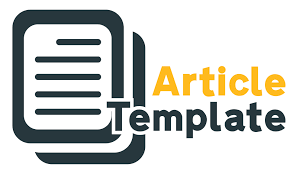DIGITAL ACCOUNTING IS THE NEW NORMAL
Keywords:
Digital Accounting; Accounting Information System; New NormalAbstract
Digital accounting is the new normal. Entering the digitalization era which is often called the industrial revolution 4.0, the phenomenon of collaborating cyber technology and automation technology forces us to adapt to technology. Responding to the negative impact of the 4.0 industrial revolution, a new idea emerged, namely society 5.0, this concept focuses on humans (human-centered) on a technology basis. One of the professional fields that can take advantage of this technology is the accounting profession. Computer-based and digital information systems play an important role in developments in the business world, as well as in the world of accounting. This paper aims to see how the influence of organizational culture, self-confidence in computers, and ease of use affect the use of Accounting Information System (AIS) in the new normal era. The type of data in this study is quantitative data. Using primary data sources, by distributing questionnaires. The population of this research is 155 Village Credit Institutions in Badung Regency. As for the sample, 75 Village Credit Institutions in Badung were taken by random sampling. It can be concluded that: culture has a significant effect on self-confidence in computers; culture has a significant effect on perceived ease of use; culture has a significant effect on the use of AIS; self- confidence in computers has a significant effect on the use of AIS; Perception of ease of use has a significant effect on the use of AIS.
References
Azzahra, B. (2020). Akuntan 4.0: roda penggerak nilai keberlanjutan perusahaan melalui artificial intelligence & tech analytics pada era disruptif. Jurnal Riset Akuntansi Dan Keuangan, 16(2), 87–100. 10.21460/jrak.2020.162.376
Bodnar, G.H. and Hopwood, W.S. 1990. Accounting Information Systems, Fourth Edition, Allyn Bacon, Boston.
Chu, M. K., & Yong, K. O. (2021). Big data analytics for business intelligence in accounting and audit. Open Journal of Social Sciences, 9, 42–52. https://doi.org/10.4236/jss.2021.99004
Cotteleer, Mark & Sniderman, Brenna, 2017. Forces of change: Industry 4.0. Published:
12.2017. Available: https://www2.deloitte.com/insights/us/en/focus/industry-4-
/overview.html Retrieved: 21.2.2019
Davis, F. D. 1989. Perceived Usefulness, Perceived Ease of Use, and User Acceptance of
Information System Technology. MIS Quarterly, 13 (3), 319-340.
Davis, F. D., R. P. Bagozzi, dan P. R. Warshaw.1989. User Acceptance of Computer
Technology: A Comparison of Two Theoretical Models. Management Science, 35 (8),
- 1003.
Deniswara, K., Handoko, B. L., & Mulyawan, A. N. (2020). Big data analytic: literature study on how big data works toward accountant millennial generation. International Journal of Management, 11(5), 376–389.
Doney, Patricia M.; Cannon, Joseph P.; and Mulen, Michael R. 1998. Understanding the Influence of National Culture on the Development of Trust, The Academy of Management Review, Vol. 23, No. 3, July, p. 601-620.
Firdaus, F. (2020). Mengenal society 5.0 “sebuah upaya Jepang untuk keamanan dan kesejahteraan manusia.” https://ee.uii.ac.id/2020/07/06/mengenal-society-5-0- sebuah-upaya-jepang-untuk-keamanan-dan-kesejahteraan-manusia/
Gro?anu, A., Fülöp, M.-T., Cordo?, G.-S., & Raita, G. (2020). Challenges and trends for the incorporation of big data in the accounting profession: from the traditional approach
to the future professional accountant. CECCAR Business Review, 1(12), 64–72. https://doi.org/10.37945/cbr.2020.12.08
Hwang, Y. 2005. Invertigating Enterprise Systems Adoption: Uncertainty Avoidance, Intrinsic
Motivation, and The Technology Acceptance Model.
Igbaria, M., S. Parasuraman, dan J. J. Baroudi. 1996. A Motivational Model of Microcomputer
Usage. Journal of Management Information Systems, 13 (1), 127-143.
Igbaria, M., N. Zinatelli, P. Cregg, dan A.L.M. Cavaye. 1997. Personal Computing Acceptance Factors in Small Firms: A Structural Equation Model. MIS Quarterly, 21 (3), 279-302.
Khanom, T. (2020). Cloud accounting: a theoretical overview. IOSR Journal of Business and
Management (IOSR-JBM), 19(6), 31–38. https://doi.org/10.9790/487X-1906053138
Mayasari, D. (2019). Mengenal society 5.0, transformasi kehidupan yang dikembangkan Jepang. https://www.timesindonesia.co.id/read/news/197889/ mengenal-society-50- transformasi-kehidupan-yang-dikembangkan-jepang.
McCoy, Scott; Galletta, Dennis F.; and King, William R. 2007. Applying TAM Across, Culture: The Need for Cauton, European Journal of Information Systems, Vol. 16, p. 81–90
Mujiono, M. N. (2021). The shifting role of accountants in the era of digital disruption.
International Journal of Multidisciplinary: Applied Business and Education Research,
(11), 1259–1274. http://www.babmrjournal.org/index.php/ijmaber/article/view/198/
Ransbotham, S., & Kiron, D. (2017). Analytics as a source of business innovation. https://sloanreview.mit.edu/projects/analytics-as-a-source-of-business-innovation/
Sadha Suardikha, I Made. 2013. “Budaya Tri Hita Karana terhadap penggunaan sistem informasi Akuntansi Dimediasi Persepsi Kegunaan”.
Setiawan, A., Praptiningsih, P., & Matondang, N. (2020). Studi literatur tentang cloud accounting. Equity, 23(2), 189–200. https://doi.org/10.34209/equ.v23i2.2236
Srite, M., J. B. Thacher, dan E. Galy. 2008. Does Within-Culture Variation Matter? An Empirical Study of Computer Usage. Journal of Global Information Management, 16 (1), 1-25.



